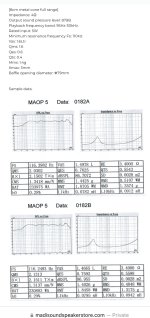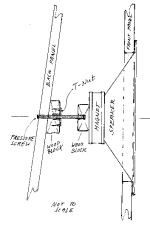This combo looking better to me, especially if looking to take it up to 30k with MAOP5 and the MA200 doing the low-mid very nicely🙂 - a bit off topic, apologies
Attachments
Last edited:
i continue the subject here: https://www.diyaudio.com/community/threads/new-markaudio-ma200-8-driver.416282/page-8
Leaving aside GM's 'outright' point that this applies to every wideband ever built (Lorelei aside if you had the power available) -you can probably draw your own conclusions from this thread, where Nandappe is using it in a single driver context, and thirteen of the sixteen designs for it that I've done for the MA site also run it in a single driver context. But this isn't the Stasi 😉 -there's no law that says you are obliged to use a wideband drive unit (any) by itself. You can, or alternately you can use them in a multiway context, as I did with that particular design, the big MTM and hybrid box / baffle semi-dipole.So the MA200, limited to WAW designs?
Last edited:
The 100-hour break-in period has been completed.
The low end has been extended and the sound is now smooth throughout the entire range.
Bass sound pressure is low, but reproduces well down to 30Hz.

The low end has been extended and the sound is now smooth throughout the entire range.
Bass sound pressure is low, but reproduces well down to 30Hz.
Smooth is great. 30hz even better. I am getting curious.
Hi LeifB60,
Above all, I appreciate that the basket is now made of die-cast aluminum.
It is much easier to install.
I wonder why Mark Fenlon was so concerned with plastic.
It gives more self-damping / dissipation of structural resonance at the price of usually needing to be larger for a given driver size, and being more expensive to produce than a cast metal type.
........and why me, P10 and others here and around the world historically have taken (some consider not worth the) effort to damp/brace them + align/bond the motor to it and then preloading it to cab to mass load it, which from ya'll's bracing scheme apparently does with maybe a bit of shimming rather than an early DIYer's pressure screw tweak.It gives more self-damping / dissipation of structural resonance at the price of usually needing to be larger for a given driver size, and being more expensive to produce than a cast metal type.
Attachments
Getting a sufficiently snug fit between those braces and the enclosure panels without stressing the driver’s basket & motor assemblies was always a fun exercise; but easier for me than trying to assess just how much torque to apply to the mounting screws before those “imaginary” washers stopped spinning.
I know everything has been done before and there is little new being thought of, but I do think there is undiscovered potential in putting some things together in new ways. And to get the best for our situation, we have to do some experimentation. I think we fullrange guys have worlds to explore here. Back or upwards firing tweeters, acoustic lenses, using enclosure types and alignments that produce more gain, using EQ to turn that gain into more headroom instead of boom, same goes for maximising room gain to advantage. Use WAW or WAT is beneficial. Use acoustic lenses. Whatever.
I recently was triggered while reading on the Audio science review forum. Someone said the limitations of fullrange drivers, such as a less than "full" bandwidth, are horrible. And he asked rhetorically whether you would enjoy a television that was incapable of showing deep orange or some other colour. That got me thinking because, obviously, a television is actually really bad at showing any other colours than Red Greed and Blue, RGB. It's the varying intensity of those colours combined per pixel that makes our eyes and brains see all the other colours. Television technology is a highly efficient way of creating a fantastic experience with a very limited representation of the original image.
When we are pointing out a dip here, a peak there and so on, I think we fall into that trap of asking rhetorical questions that don't make much sense in hindsight. I performed Mahler symphonies in a world famous concert hall, with world famous acoustics. 120 student musicians on stage, two choirs totalling 80 singers, there is no way the 3d acoustic soundfield of that is captured in a stereo recording, and no way this is reproduced by two loudspeakers in a living room. But we get pretty close and that's because there is an RGB pixel analogue for audio as well.
What I aim for, is finding that 4K 100Hz RGB HDR solution to getting my ears and brain to hear that 200 musicians and singers happening on my system. With my ears/brain/room/acoustics/budget/leaving space to walk through the room. 😜
I recently was triggered while reading on the Audio science review forum. Someone said the limitations of fullrange drivers, such as a less than "full" bandwidth, are horrible. And he asked rhetorically whether you would enjoy a television that was incapable of showing deep orange or some other colour. That got me thinking because, obviously, a television is actually really bad at showing any other colours than Red Greed and Blue, RGB. It's the varying intensity of those colours combined per pixel that makes our eyes and brains see all the other colours. Television technology is a highly efficient way of creating a fantastic experience with a very limited representation of the original image.
When we are pointing out a dip here, a peak there and so on, I think we fall into that trap of asking rhetorical questions that don't make much sense in hindsight. I performed Mahler symphonies in a world famous concert hall, with world famous acoustics. 120 student musicians on stage, two choirs totalling 80 singers, there is no way the 3d acoustic soundfield of that is captured in a stereo recording, and no way this is reproduced by two loudspeakers in a living room. But we get pretty close and that's because there is an RGB pixel analogue for audio as well.
What I aim for, is finding that 4K 100Hz RGB HDR solution to getting my ears and brain to hear that 200 musicians and singers happening on my system. With my ears/brain/room/acoustics/budget/leaving space to walk through the room. 😜
how you have find it vs sb20 or a maop 10
MAOP10 for quality, SB20FRPC30-8 for cost performance, and MA200-M for ease of use.
Please refer to the following URL
MA200-M
SB20FRPC30-8
MAOP10.2
After 100 hours of break-in, I feel that the drive force is not strong enough.
I tried additional magnets, and 30φx3mmx5piece seems to be a good choice.
The TS parameter did not change much, but the clarity was improved and the sharpness of the low frequency range, which I was dissatisfied with, was also improved.
But the sound vector is different from MAOP10 and SB20FRPC30-8.

I tried additional magnets, and 30φx3mmx5piece seems to be a good choice.
The TS parameter did not change much, but the clarity was improved and the sharpness of the low frequency range, which I was dissatisfied with, was also improved.
But the sound vector is different from MAOP10 and SB20FRPC30-8.
Always liked that pressure-screw method. 🙂 Probably next best thing to the rear-mount driver & the floating baffle...........and why me, P10 and others here and around the world historically have taken (some consider not worth the) effort to damp/brace them + align/bond the motor to it and then preloading it to cab to mass load it, which from ya'll's bracing scheme apparently does with maybe a bit of shimming rather than an early DIYer's pressure screw tweak.
The braces are pretty good too, if a bit harder to adjust! 😉 Dave will probably be after my blood, but when my friend & cabinet-building partner in crime Colin was still with us (rest in peace, my friend) we slightly oversized the driver cutout in the front-rear brace & used adhesive cork tape to shim it to the driver. Tiny amount of initial compression, then quite rigid.
They can mount up as well -as Dave Brailsford would say, marginal gains.
That said -there does come a point where it's a good idea to say 'enough is enough', as that way can lead to madness. Room aside, it's one reason I spent years avoiding vinyl again, as I know perfectly well what would happen: I'd spend all my time thinking about adjusting the deck and not enough on the music. Of course, what do I then go and do? Inherit my late, much-missed friend Colin's Hydraulic Reference -a deck with the most serpentine belt layout known to woman-born, and you only need to look at it sideways for the thing to fall off. It also happens to have the very last SME 3009 MkII Improved [fixed headshell, no less] arm ever produced on it. Fame at last. And another utter PITA, since there are about three modern cartridges that you can actually use on the thing. I wouldn't be without it though, obviously.
That said -there does come a point where it's a good idea to say 'enough is enough', as that way can lead to madness. Room aside, it's one reason I spent years avoiding vinyl again, as I know perfectly well what would happen: I'd spend all my time thinking about adjusting the deck and not enough on the music. Of course, what do I then go and do? Inherit my late, much-missed friend Colin's Hydraulic Reference -a deck with the most serpentine belt layout known to woman-born, and you only need to look at it sideways for the thing to fall off. It also happens to have the very last SME 3009 MkII Improved [fixed headshell, no less] arm ever produced on it. Fame at last. And another utter PITA, since there are about three modern cartridges that you can actually use on the thing. I wouldn't be without it though, obviously.

I love tweaks. Even when they give small difference.
Of cource not expensive things.
Of cource not expensive things.
Ah yes. I remember when I discovered each record has a different thickness and that setting vertical tracking angle on one record could deliver a great result on one album, and be off significantly for another. I think that was the moment that triggered my move to a pragmatic (strictly digital) approach to sound sources. 🤣Room aside, it's one reason I spent years avoiding vinyl again, as I know perfectly well what would happen: I'd spend all my time thinking about adjusting the deck and not enough on the music.
In Japan, Danny Boy by Jacintha is known as a high quality sound source and is often used for demonstrations at audio events, but MA200-M does not sound good with harsh consonants.
I was looking for an alternative and found Both Sides Now - Jeanette Lindström.
This song works well with MA200-M and gives a great voice.
I was looking for an alternative and found Both Sides Now - Jeanette Lindström.
This song works well with MA200-M and gives a great voice.
- Home
- Loudspeakers
- Full Range
- MarkAudio MA200-M + DDVP-20(TQWT)

